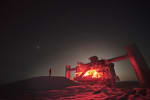As the sun rises and brightens the sky, thoughts turn to the arrival of summer visitors. Still a ways off, but there is plenty of station prep and cleaning to be done in the meantime. Outside, the IceCube Lab and some other structures are now becoming visible again in daylight. […]
News
Week 35 at the Pole
The satellite dome sits frosted over as it waits for the sunrise—here it’s shown backlit by a full moon. It’s a peaceful scene, which is also how IceCube’s winterovers generally described last week at the Pole. […]
Understanding inelasticity in high-energy neutrino interactions with IceCube
The IceCube Collaboration has recently presented its first measurements of the neutrino inelasticity, which are also the first-ever at very high energies—from 1 TeV up to nearly 800 TeV. The inelasticity distribution was found to be in good agreement with Standard Model prediction and was later used to perform other measurements, such as charm production in neutrino interactions or flavor composition of astrophysical neutrinos. […]
Week 34
IceCube winterover Johannes’s camera withstood a time-lapse session outdoors last week—a little frosty looking afterward but still able to crank out some fine-looking photos. […]
Week 33 at the Pole
False alarm from week 32—aurora viewing remained in full force last week at the Pole. In fact, the skies were graced with some purple auroras, pretty rare in general, even at the bottom of the world. […]
Week 32 at the Pole
Who knows, but it could be that this fantastic shot is the last we’ll see of the auroras from the Pole for a while. So, why not go out with a bang—big, bright, and set against a starry Milky Way backdrop. […]
Week 31 at the Pole
It was a pretty busy time last week at the Pole. IceCube’s winterovers had some unrelated hardware incidents that required troubleshooting and fixing, and a trip out to the IceCube Lab. And look what a great photo winterover Raffaela captured on that trip, with the ICL backlit by a full moon. […]
WIPAC professor Stefan Westerhoff dies at 50
Stefan Westerhoff, a professor in the physics department at the University of Wisconsin–Madison, passed away on Sunday, August 5, 2018, after a long illness. He was 50. […]
Week 30 at the Pole
Last week the weather was a bit mixed, and the winterovers had their lunar eclipse viewing marred by blowing snow. Regardless, they still got together outdoors for a group photo. […]
Constraints on neutrino emission from short-lived transient sources
In a new search for neutrino sources, the IceCube Collaboration and other collaborators have looked for short-lived transient sources, including gamma-ray bursts, core-collapse supernovae, or neutron star mergers. The search, which looked for two or more neutrinos detected within 100 seconds from the same location, included transients that might not emit gamma rays and might be pointing to uncharted objects in the universe. The results submitted this week to Physical Review Letters did not identify any individual source but did show that the number of bright short-lived transient neutrino sources must be small or they must be fairly faint. […]









